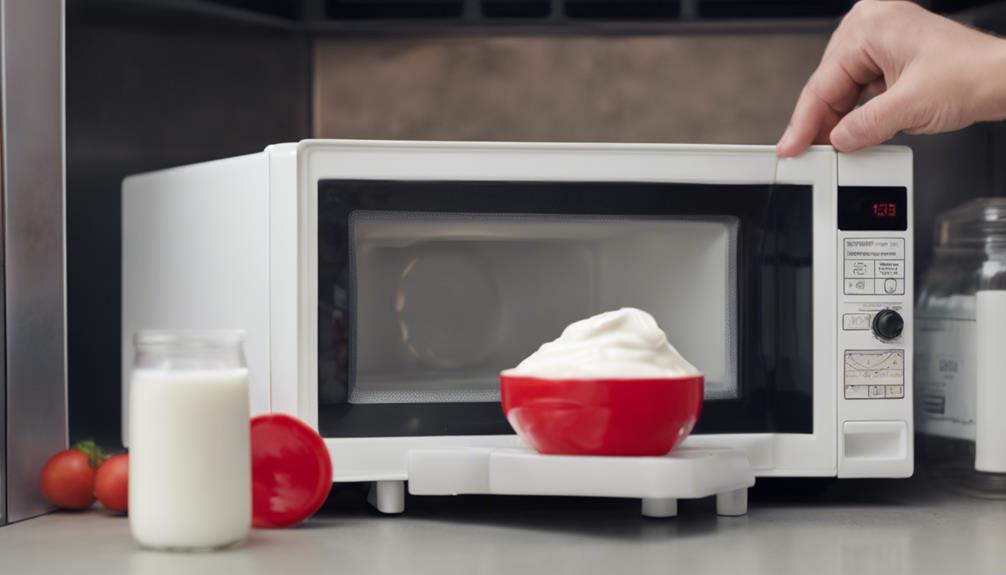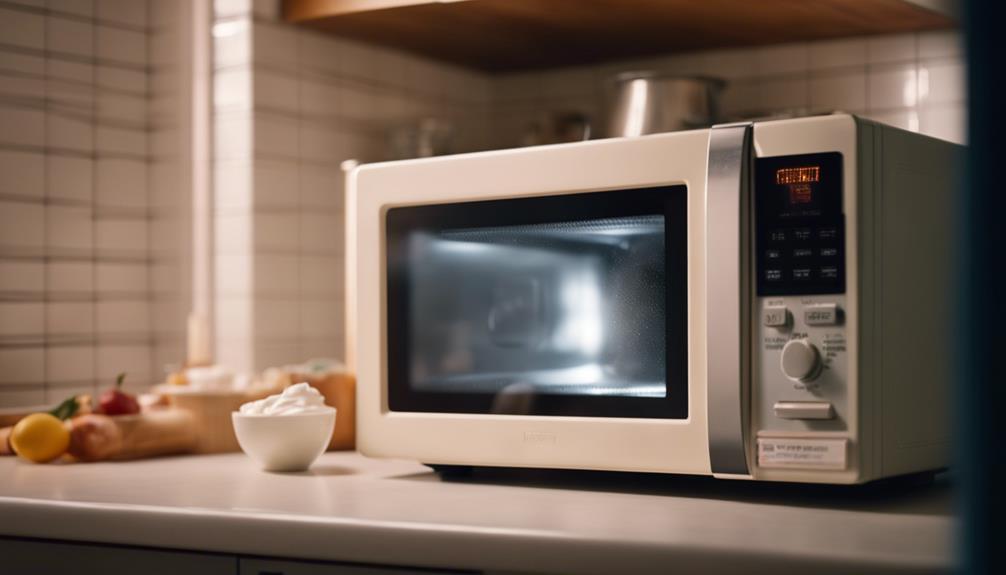Can You Microwave Yogurt
Yes, you can microwave yogurt. However, it's important to exercise caution and follow the right approach to prevent any undesirable changes in its texture or taste.
When microwaving yogurt, it's best to do so in short intervals, stirring in between, to ensure even heating. Avoid overheating the yogurt as it can cause it to curdle or separate.
Additionally, using a microwave-safe container and covering it with a microwave-safe lid or plastic wrap can help retain moisture and prevent any splattering.
Ultimately, microwaving yogurt can be a convenient way to enjoy a warm serving, but it's important to be mindful of the process to maintain its creamy and delicious qualities.
Key Takeaways
- Microwaving yogurt is safe and preserves nutrients better than boiling.
- Use low power settings to heat gently and prevent curdling.
- Incorporate flavor-enhancing ingredients for a tasty experience.
- Yogurt can be a versatile ingredient in cooking, adding creaminess and depth to dishes.
Safety Precautions for Microwaving Yogurt
When microwaving yogurt, it is important to observe safety precautions to preserve its beneficial bacteria and prevent undesirable changes in taste and texture. The temperature is a critical factor to consider, as heating yogurt above 130°F can kill the healthy bacteria present in it. Excessive heat can also lead to the curdling of yogurt, resulting in alterations to its taste and texture.
To avoid these issues, it is recommended to use low settings on the microwave and refrain from boiling yogurt. Additionally, stirring microwaved yogurt can help in mixing it back together if it separates. Always handle hot yogurt with caution to prevent burns, ensuring a safe and enjoyable microwaving experience.
Best Practices for Heating Yogurt
When heating yogurt, it is crucial to maintain temperatures below 130°F to preserve its beneficial bacteria.
Using low microwave settings can prevent overheating and unwanted texture changes.
Ensuring proper handling to avoid burns when removing the yogurt from the microwave is essential for a safe heating process.
Heating Yogurt Safely
To ensure the nutritional benefits and texture of yogurt remain intact, it is essential to heat it gently and avoid exposing it to temperatures above 130°F. When heating yogurt, especially those made from milk, it's crucial to follow best practices to retain its quality:
- Heat gently to preserve healthy bacteria.
- Avoid boiling to prevent curdling.
- Stir if separation occurs after heating.
- Utilize low microwave settings to maintain the yogurt's properties.
Ideal Microwave Settings
For optimal results when heating yogurt in the microwave, it is advisable to utilize low power settings, such as 10-20%, to ensure gentle heating and prevent overheating. This method helps maintain the integrity of the yogurt, especially for varieties like Greek yogurt that can curdle or separate if exposed to high temperatures. Below is a table summarizing the ideal microwave settings for heating yogurt effectively:
| Power Level | Time | Observations |
|---|---|---|
| 10% | 30s | Gentle heating |
| 15% | 20s | Slow and even warming |
| 20% | 15s | Minimal risk of overheating |
| 5% | 45s | Longer duration, use for sensitive yogurt types |
Tips to Preserve Yogurt's Flavor

To maintain and enhance the flavor of yogurt, consider incorporating flavor-enhancing ingredients. Utilize proper storage techniques and adhere to serving temperature recommendations.
By following these tips, you can ensure that your yogurt retains its delicious taste and quality, providing a satisfying culinary experience every time.
Remember to pay attention to these details to fully enjoy the goodness of your yogurt.
Flavor-Enhancing Ingredients
Enhancing the flavor of microwaved yogurt can be achieved by incorporating a variety of complementary ingredients such as honey, maple syrup, or agave nectar. To preserve the flavor of yogurt while microwaving, consider the following tips:
- Sprinkle cinnamon, nutmeg, or vanilla extract for added depth and aroma.
- Mix in chia seeds, flaxseeds, or granola to provide texture and nutritional benefits.
- Experiment with different fruit combinations like berries, bananas, or peaches to create a variety of flavors.
- Opt for flavored Greek yogurt as a base to amplify the taste profile of the microwaved yogurt while maintaining its original flavor.
Proper Storage Techniques
Implementing proper storage techniques is essential for maintaining the flavor and freshness of yogurt, especially when dealing with homemade yogurt. To preserve its taste, store homemade yogurt in a sealed container in the refrigerator and consume it within a week of preparation.
Keeping the yogurt covered at all times will prevent it from absorbing other flavors and odors in the fridge. When serving yogurt, use clean utensils to avoid contamination and maintain its original taste.
Avoid leaving yogurt at room temperature for extended periods to prevent spoilage and undesired flavor changes. By following these storage tips, you can ensure that your homemade yogurt retains its optimal flavor and quality for a delightful culinary experience.
Serving Temperature Recommendations
When considering the optimal serving temperature for yogurt to maintain its flavor and texture, it is crucial to avoid microwaving it above 130°F to preserve the beneficial bacteria and taste integrity.
- Serve yogurt between 70-78°F
- Avoid heating yogurt above 130°F
- Gently heat yogurt in the microwave
- Stir microwaved yogurt to distribute heat evenly
Following these guidelines will help ensure that the yogurt retains its nutritional benefits and delicious taste. Remember, gentle heating methods and careful temperature control are key to preserving the quality of yogurt when using the microwave.
Common Mistakes to Avoid

To prevent detrimental changes in yogurt's taste and texture, it is crucial to avoid overheating it above 130°F when microwaving. One common mistake to avoid is using a glass bowl, as it can cause the yogurt to heat unevenly and potentially reach temperatures above the recommended threshold. Additionally, microwaving yogurt for too long can lead to curdling and unpleasant alterations in its properties. It is essential to stir the yogurt after microwaving to ensure it mixes back together if any separation or changes occur. Using low microwave settings is advisable to retain the yogurt's health benefits and taste, while preventing it from boiling and maintaining its nutritional value and consistency.
| Common Mistakes to Avoid | Tips for Success |
|---|---|
| Overheating above 130°F | Use low settings |
| Using a glass bowl | Stir after microwaving |
| Microwaving for too long | Avoid boiling |
Creative Ways to Use Microwaved Yogurt
Utilizing microwaved yogurt as a versatile ingredient opens up a realm of culinary possibilities, enhancing dishes with its creamy texture and tangy flavor profile. Here are some creative ways to incorporate this dairy product into your cooking:
- Use microwaved yogurt as a base for smoothies or parfaits.
- Incorporate microwaved yogurt into baking recipes for added moisture and richness.
- Top pancakes, waffles, or oatmeal with microwaved yogurt for a tangy twist.
- Create a creamy salad dressing by mixing microwaved yogurt with herbs and spices.
Final Thoughts on Yogurt and Microwaving

In conclusion, the practice of microwaving yogurt can be a convenient method for incorporating this dairy product into various recipes, but proper care must be taken to ensure that the yogurt's beneficial properties are preserved.
Heating yogurt above 130°F should be avoided as it can lead to curdling and changes in taste and texture. To prevent this, it is advisable to use low microwave settings and heat the yogurt in short intervals. If separation occurs, stirring the microwaved yogurt can help restore its consistency. Experimenting with alternative warming methods, such as leaving yogurt at room temperature or using warm water, can also help maintain its benefits.
Frequently Asked Questions
Can You Microwave Yogurt in Its Original Container?
Heating yogurt in its original container can lead to changes in yogurt consistency due to excessive heat exposure, potentially causing curdling. To maintain texture, transfer yogurt to a ceramic or glass dish before microwaving.
Can Microwaving Yogurt Affect Its Probiotic Content?
Microwaving yogurt can indeed impact its probiotic viability. Excessive heat exposure during microwaving can diminish the beneficial probiotic content of yogurt. To preserve these health benefits, it is advisable to avoid overheating yogurt and consider alternative warming methods.
How Long Can Microwaved Yogurt Be Stored in the Refrigerator?
Refrigerator storage of microwaved yogurt can last up to 7 days when kept covered for freshness. Always use clean utensils to scoop out yogurt to prevent contamination. Proper storage is crucial to preserve quality; discard any spoiled batches promptly.
Can You Microwave Yogurt With Fruit or Other Mix-Ins Already Added?
When heating yogurt with pre-added fruit or mix-ins in the microwave, consider the impact on yogurt consistency. Microwaving may lead to uneven flavor distribution and textural changes. It's advisable to add these ingredients post-microwaving for optimal freshness and integrity.
Can Microwaving Yogurt Cause It to Curdle or Separate?
Microwaving yogurt can lead to curdling or separation due to excessive heat altering its texture. This process can denature proteins and kill beneficial bacteria. To maintain microwave safety, warm yogurt gradually on low settings and stir for consistency.
Conclusion
In conclusion, microwaving yogurt requires caution to maintain its properties. By following safety precautions and best practices, yogurt can be warmed without compromising its health benefits and taste.
Remember to handle yogurt delicately, like a fragile piece of glass, to preserve its integrity and ensure a satisfying experience.






